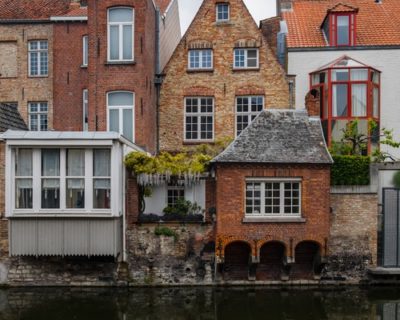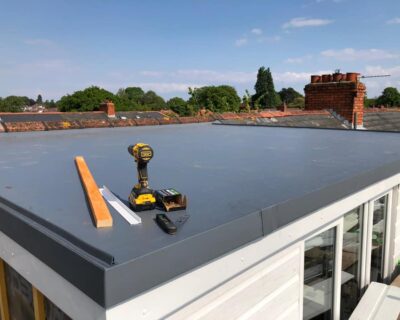Blog & News

Can I Install Solar Panels on My Flat Roof?
With so many households and businesses in the UK embracing more sustainable energy sources, this is a question we are asked a lot: Can you install solar panels on your flat roof? The answer is yes, absolutely.
While there are specific considerations to be taken into account when thinking about installing solar panels on a flat roof (more on those later), it’s a popular choice to make for both commercial and domestic properties. Flat roofs provide a simple starting point to designing a solar panel array, and can also become home to solar thermal systems too. While in many areas of the UK planning permission won’t be necessary, it’s always best to seek the advice of your local planning authority (LPA) before making definite plans, to ensure you’re following all the official guidelines.
Before you start planning, here’s our guide to everything you need to know about installing solar panels onto a flat roof.
Benefits of a Flat Roof Solar Panel System
The benefits of using solar panels are well known. But to refresh your memory, there are two main benefits of adopting a solar panel system:
- A more sustainable, greener source of energy (reduced carbon footprint)
- Lower energy bills
Sounds pretty good to us! Now we’re probably biased, but there are benefits specific to using solar panels on flat roofs, including:
- Easy installation and maintenance due to the area being flat and more accessible than a pitched roof
- Cheaper installation and maintenance, due to the ease of accessibility and lower risk
- The panels are less visible or even invisible from the street once fitted, thus not impacting your curb appeal or upsetting neighbours
- More room for the panels to be installed
- More design and layout options for optimal panel positioning when compared to a pitched roof.
Solar panels really can be a great addition and can add value to your property, which is good news if you are planning to sell and move on in the future. If not, you can rest assured knowing that you are embracing a greener source of energy for your home or business, and using your flat roof to its full potential.
Installing Solar Panels onto a Flat Roof

Your roof is flat, so you can just put the panels on top and ‘Voila!’ job done, right? Well, no, unfortunately it’s not quite that simple!
There’s no doubt that using solar power is a great choice for many reasons, but it’s also important to consider the wider impact of fitting solar panels onto your flat roof. You must ensure that your solar panels don’t compromise the roof’s primary function, which is to remain watertight and insulated, protecting the interior of the property from external elements.
Rather than simply putting solar panels on top of your flat roof, your solar panel system will need to be designed and fitted to your specific requirements. Great care must be taken over the layout of the panels on a flat roof to ensure they work to their maximum potential.
Designing Your Solar Panel Array
While solar panels on a pitched roof simply follow the orientation and pitch of the roof, with a flat roof, the exact layout and pitch can be designed specifically for the setting. This is great if you have a large roofscape to work with, but does present its own challenges if you have a smaller or more awkwardly shaped flat roof.
By working with qualified solar panel experts and experienced installers, like Sureseal, you will know that your roof and solar panels are in safe hands.
Want to know more about solar panels or any aspect of flat roofing? Fill out the contact form for a free, no-obligation quote.
Special Considerations for Solar Panels on Flat Roofs
The panel array needs to be pitched to promote self-cleaning and best capture the UV energy from the sun. The design also needs to ensure panels won’t be shaded by other panels, surrounding things like trees, chimneys, or taller buildings, or lift machinery housing, air conditioning units, or plant rooms, which are often found on the roofs of many commercial buildings.
There are other special considerations to take into account when installing solar panels onto a flat roof that aren’t necessary on pitched roofs, like optimal pitch, wind loading, and ideal orientation.
What Angle Should the Panels Be Installed At?
In the UK, it is recommended that the pitch of solar panels on a flat roof is somewhere between 10-50° from horizontal, but there are varying degrees of ‘optimal pitch’ within that range.
10° is the minimum pitch required for the panels to be self-cleaning, i.e. it is the gentlest slope needed for rainwater to reliably be able to wash away dust or debris from the surface of the panels. This helps the panels work to their maximum potential.

20° to 30° is considered optimal pitch for most designs in the UK, to ensure they will be self-cleaning. It offers a more productive angle to best capture the sun’s energy, but not so steep that they require extra support.
Pitches between 30° and 50° are usually only used in situations where a lower pitch is not possible for site-specific reasons.
While you may initially assume that panels with a higher pitch will allow more room for panels on a flat roof, the truth is actually the opposite. The higher the pitch of the panel, the longer the shadow it creates, and therefore the more space is needed before the next row of panels to be installed out of the way of any shade.
How to Mitigate the Risk of High Winds
Under the force of high winds, unsecured or poorly fitted solar panels can be damaged or even displaced. It is therefore absolutely paramount to choose the right fitting method for your solar panels to mitigate any risk from high winds.
There are two main ways of fitting solar panels to flat roofs to make sure they are secure under extreme weather.
The first option is to fit the solar panel frame into the structure of the roof construction below the roof line, meaning fittings will penetrate through the outer roof membrane layer. Although this will make for a secure panel system, it can be a costly method, as specific fittings are required and there is the risk factor of damaging the roof’s waterproof integrity. Penetrating the roof’s surface may also interfere with the product warranty of your roof materials. Therefore, this option is mostly used on new build roofs, where the solar panel fittings can be worked into the initial construction of the roof and will disrupt the installation of the roof the least.
The second option is perhaps the most common – solar panels are fitted to an existing flat roof by using weighted frames. Ballast materials like heavy concrete slabs or stone chippings anchor the panels onto the roof, and rubber feet on the frames help distribute the weight over the surface of the roof. This option doesn’t interfere with the roof materials, construction, or warranties, so may be an easier option. However, if your panels have a higher pitch, the amount of ballast needed to keep the panels secure may become too heavy for your roof structure to handle.
In both circumstances, it is absolutely essential to consult both your solar panel installers and roofing specialists to ensure the roof design and solar panel design are compatible.
Which Direction Should the Array Be Orientated?
In the UK, the optimal direction for your solar panel array is due south, to best capture the sun’s energy. However, there will be instances where due south is not a practical choice for your solar panel installation. For example, if the footprint of your property runs in a northeast to southwest direction, you would fit fewer panels at a due south direction on your roof than you would if you followed the orientation of your roofscape. A larger array set at a different orientation may produce a larger output than fitting a smaller array at a due south orientation.
In solar panel designs, rows of panels facing in the same direction are common. If your property has a south-facing footprint however, an east–west solar array is an alternative option. This is where rows of panels sit back to back in a zigzag profile, facing east and west alternately. By using this design, you don’t need to leave any space between rows, therefore maximising the number of panels you can fit on a roof space, and your solar system’s output.
Consult a Specialist
It is important to consult with your solar panel specialist to calculate exactly the best layout and orientation for your solar panel system. At Sureseal Flat Roofing, we work alongside solar installers to ensure your roof is strong, watertight, and able to carry the load of your desired solar panel array. We have years of experience and a dedicated team of installers, so if you’re thinking of renovating your flat roof and installing solar panels, contact Sureseal to see how we can help.



